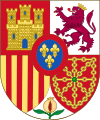Timeline of Córdoba, Spain
Prior to 20th century
See also: Corduba (Roman city)
- 152 BCE - Romans in power.[1]
- 45 BCE - Battle of Munda occurs near Cordoba.[2]
- 294 CE - Hosius becomes bishop.[3]
- 554 CE - Byzantines in power.[1]
- 571 - Visigoth Liuvigild in power.[1]
- 719 - Capital of al-Andalus relocated to Cordoba from Seville.[1]
- 785 - Great Mosque of Córdoba built.[4]
- 880 - Earthquake.[1]
- 929 - Umayyad Abd-ar-Rahman III becomes Caliph of Córdoba.[4]
- 936 - Madinat Al-Zahra construction begins.[5]
- 1009 - Civil war begins.[5]
- 1236 - Mosque converted into Cathedral of Córdoba.[5]
- 1315 - Synagogue founded (approximate date).[5]
- 1857 - Population: 42,909.[6]
20th century
- 1910 - Population: 66,831.[6]
- 1930 - Population: 103,106.[6]
- 1979 - Julio Anguita becomes mayor.
- 1981 - Population: 284,737.[6]
21st century
- 2008 - Population: 325,453.
- 2011 - José Antonio Nieto becomes mayor.
See also
- Córdoba history
- History of Córdoba, Andalusia
- List of mayors of Córdoba
- Timelines of other cities in the autonomous community of Andalusia: Almería, Cádiz, Granada, Jaén, Jerez de la Frontera, Málaga, Seville
- List of municipalities in Andalusia
References
- Bosworth 2007.
- Ring 1996.
- Garcia Osuna 1908.
- "Iberian Peninsula, 500–1000 A.D.: Key Events". Heilbrunn Timeline of Art History. New York: Metropolitan Museum of Art. Retrieved 30 November 2014.
- Grove 2009.
- "Alterations to the municipalities in the Population Censuses since 1842: Córdoba". Instituto Nacional de Estadística (Spain). Retrieved 30 November 2014.
This article incorporates information from the Spanish Wikipedia.
Bibliography
- Published in the 19th century
- "Spain: Cordova", Cities and Principal Towns of the World, Cabinet Cyclopaedia, London: Longman, Rees, Orme, Brown, & Green, 1830, OCLC 2665202
- Arthur de Capell Brooke (1831), "Cordova", Sketches in Spain and Morocco, London: Henry Colburn and Richard Bentley, OCLC 13783280
- Richard Ford (1855), "Cordova", A Handbook for Travellers in Spain (3rd ed.), London: J. Murray, OCLC 2145740
- John Lomas, ed. (1889), "Cordova", O'Shea's Guide to Spain and Portugal (8th ed.), Edinburgh: Adam & Charles Black
- Published in the 20th century
- Albert Frederick Calvert (1907), Cordova, a city of the Moors, London: J. Lane, OL 23291161M
- "Cordova", Jewish Encyclopedia, 4, New York, 1907, hdl:2027/osu.32435029752912
- "Cordova", Spain and Portugal (3rd ed.), Leipzig: Karl Baedeker, 1908, OCLC 1581249
- Manuel Garcia Osuna (1908). "Cordova". Catholic Encyclopedia. New York.
- Somerset Maugham (1920). "Cordova". Land of the Blessed Virgin; Sketches and Impressions in Andalusia. New York: A.A. Knopf. hdl:2027/nyp.33433081585832.
- Philip Khuri Hitti (1973). "Cordova". Capital Cities of Arab Islam. University of Minnesota Press. ISBN 978-0-8166-0663-4.
- Robert Hillenbrand (1992). "'The Ornament of the World': medieval Cordoba as a cultural centre". In Salma Khadra Jayyusi (ed.). The Legacy of Muslim Spain. EJ Brill. ISBN 90-04-09599-3.
- Trudy Ring, ed. (1996). "Cordoba". Southern Europe. International Dictionary of Historic Places. 3. Fitzroy Dearborn. pp. 155+. OCLC 31045650.
- Published in the 21st century
- Clifford Edmund Bosworth, ed. (2007). "Cordova". Historic Cities of the Islamic World. Leiden: Koninklijke Brill. pp. 102+.
- "Cordoba". Grove Encyclopedia of Islamic Art & Architecture. Oxford University Press. 2009. ISBN 978-0-19-530991-1.
- Ann Christys (2010). "The meaning of topography in Umayyad Córdoba". In Caroline Goodson; et al. (eds.). Cities, Texts, and Social Networks, 400-1500: Experiences and Perceptions of Medieval Urban Space. Ashgate Publishing, Ltd. ISBN 978-0-7546-6723-0.
- David Gilmour (2012). "Cordoba". Cities of Spain. Random House. ISBN 978-1-4481-3833-3.
External links
| Wikimedia Commons has media related to History of Córdoba, Spain. |
- "Spain: Cordoba". Archnet. Archived from the original on 5 May 2008.
- Europeana. Items related to Córdoba, various dates.
- Digital Public Library of America. Items related to Córdoba, various dates
This article is issued from Wikipedia. The text is licensed under Creative Commons - Attribution - Sharealike. Additional terms may apply for the media files.
